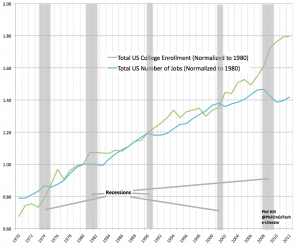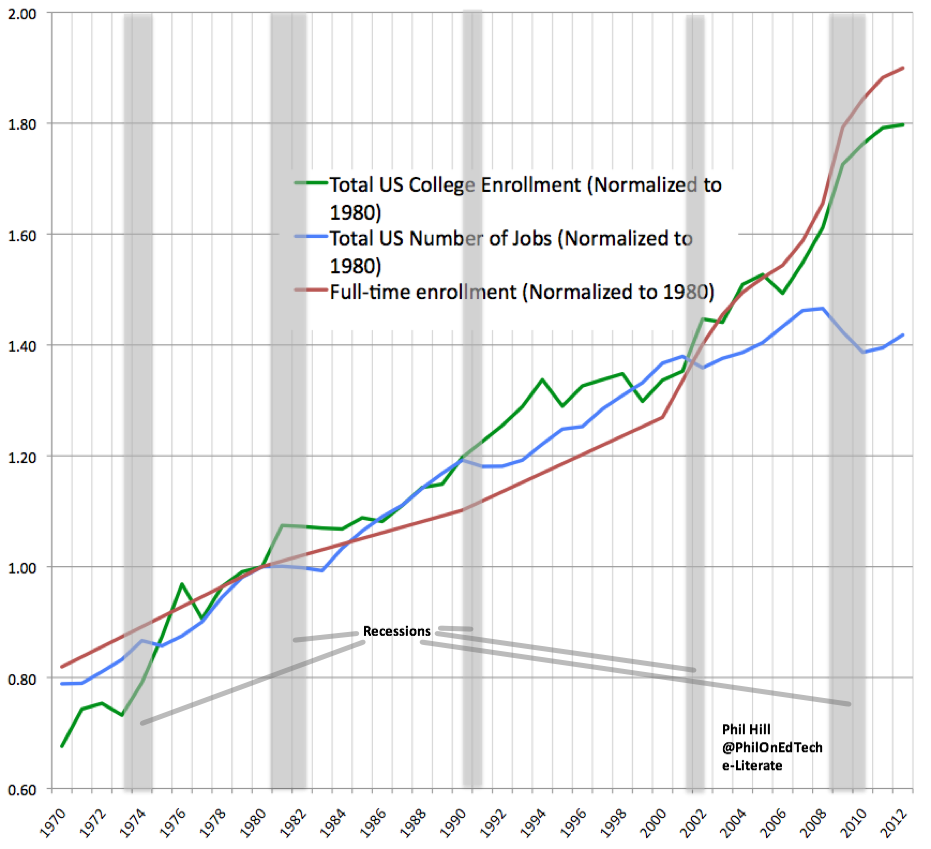In a post two days ago, I showed US data comparing enrollment and employment trends. The salient feature of the data that I called out was the significant divergence of the two trend lines since 2006.
When you look at the data from 1970 – 2012, the results could explain some significant pressures experienced by higher education institutions. In a nutshell – this time is different, we are in uncharted territory.
There are two related comments that I would like to address, both of which ask the question of whether the mix of full-time vs. part-time enrollment explains part of the divergence noted.
The first (excerpted) comment is from Thomas Warger under the original post:
I have to wonder how much of the gap you show here can be attributed to the increased availability of pay-as-you-go higher education–opportunities to take a few credits at a time at a community college or an online provider? Does “normalized for 1980″ factor for this relatively new phenomenon?
The second comment is from Stephen Downes in his OLDaily blog:
I don’t agree with the proposition that “this time it’s different.” Here’s what Phil Hill writes: “The conventional wisdom holds that enrollment jumps when employment drops, and the data does show some divergence followed a few years later by a correction. What is different this time is A) the magnitude of the divergence and B) the start of the divergence fully two years before the recession started in 2008.” I think the apparent spike in enrollments is created by a lot of part-time and online learning, and that it is a bit illusory. It’s also caused by echo-boom effects, as the population born between 1982-1995 is in post-secondary education between 2002-1015, give or take. If (and it’s a big if) employment improves, I would expect a dramatic drop in (traditional) enrollment.
What’s really different is that world population is reaching a breaking point, climate change is disrupting food supplies and other industry, resource depletion has become a significant problem, and (by contrast) worldwide prosperity, literacy and general awareness has led to an increasingly restive global population. There is moreover a chronic economic imbalance, with increasingly large quantities of wealth simply being hoarded instead of invested (it’s an amount that if deployed would makemoney itself meaningless). U.S. demographic trends – which could be rendered obsolete with one major wave of immigration – are irrelevant in the face of these wider forcess.
Both of these comments ask valid questions, and I thought it would be worthwhile to add the full-time enrollment data into the chart.
What comes out, surprisingly, is that the divergence of enrollment and employment starting in 2006 does not come mostly from the increase in pay-as-you-go or part-time enrollment. Full-time enrollment itself not only shows the same pattern, it also diverges to a greater degree than total enrollment.
I should also clarify what I mean by “this time is different”:
- We are in a new situation with respect to the relationship of employment and enrollment data that is outside the limits of what we have experienced in prior years. This means that we don’t know how to extrapolate and predict the impacts, and I suspect we are seeing non-linear effects. We are leaving the previous status quo, and we are in transition to a new, unknown status quo.
- There are tremendous macro-economic stresses being placed on the higher education system due to the large increase in number of enrolled degree-seeking students without a corresponding large increase in the number of jobs available. The effect of these macro-economic forces should force the system to come up with new, lower-cost, and more-flexible options for people seeking degrees.
- While an significant increase in the number of jobs would reduce the macro-economic stresses resulting from the divergence, the genie is out of the bottle in my opinion. We could not add enough jobs fast enough to undo the changes that are occurring over the past few years.
What I don’t mean is that the divergence in US demographic trends is the only reason that “this time is different”. My intention is to present some data to illustrate one of the more interesting causes of change. As such, I agree with Stephen that global forces such as population growth, increasingly restive global population, and economic imbalance could end up being even more important than US demographic trends. However, this argument also points to real, irreversible change.
I appreciate the comments – this dialogue is useful to explore the nature of change in higher education.

